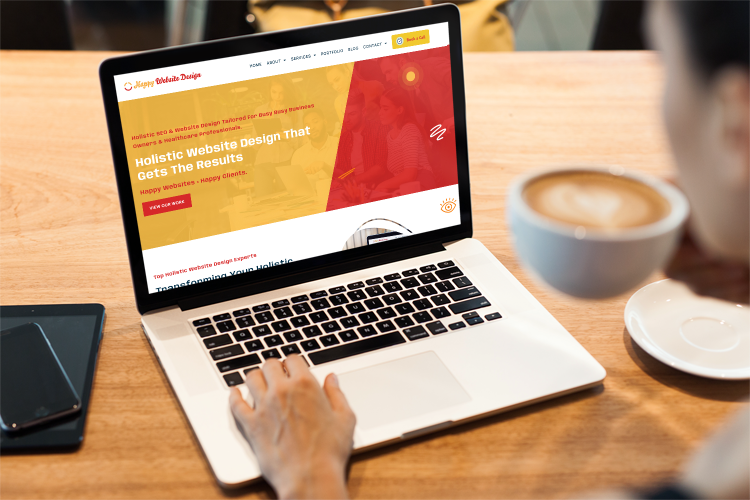Why Holistic Website Design Is the Key to a Seamless Customer Experience
In today's digital landscape, the value of alternative internet style can not be overemphasized, as it elaborately weaves with each other looks, usability, and capability to create a smooth user experience. By embracing an extensive strategy that prioritizes individual needs and leverages comments, developers can enhance the total communication with their platforms.
Comprehending All Natural Web Layout
Including customer comments and behavioral data is vital in alternative website design. This repetitive process aids developers to determine pain factors and locations for improvement, ensuring that the end product resonates with users. In addition, alternative design emphasizes the importance of access, making sure that all users, despite their capabilities, can browse and communicate with the internet site properly.
Additionally, the combination of receptive style concepts is important in accommodating numerous tools and display sizes, better boosting the individual experience. By understanding the interconnectedness of these parts, designers can produce websites that not only bring in but likewise preserve users, eventually driving involvement and conversions. Alternative website design is, for that reason, a critical approach that fosters a significant partnership in between users and electronic rooms, leading the way for lasting on-line success.
Key Elements of Holistic Style

One more crucial component is uniformity in visual and useful elements throughout the web site. This involves keeping a cohesive shade combination, typography, and format, which assists customers navigate the website without effort - happy web design. Additionally, receptive design is necessary, guaranteeing that the internet site does optimally throughout numerous gadgets and display sizes
Access is likewise an essential element of all natural design. By sticking to accessibility requirements, developers can create comprehensive experiences that provide to diverse individual teams, including those with specials needs. The combination of material strategy makes sure that useful details is provided clearly and succinctly, enhancing comprehension and involvement.
Last but not least, efficient cooperation amongst style, development, and advertising teams fosters a unified vision that lines up with service purposes. By concentrating on these crucial elements, holistic website design can provide an enhancing individual experience that is both interesting and useful.
Advantages of a Smooth Experience
Developing a smooth customer experience supplies countless advantages that significantly enhance overall fulfillment and interaction. moved here At its core, a seamless experience promotes a sense of ease and intuitiveness, allowing customers to browse an internet site or application easily. This decrease in friction not only enhances the likelihood of users returning but additionally boosts their readiness to advise the system to others.
Additionally, a seamless experience results in improved conversion prices. When customers discover what they need with marginal initiative, they are a lot more inclined to finish preferred actions, such page as purchasing or registering for an e-newsletter. This effectiveness translates right into higher customer retention, as completely satisfied individuals are most likely to come to be faithful advocates for the brand name.
Furthermore, a cohesive and seamless user interface minimizes cognitive load, permitting individuals to focus on material as opposed to dealing with navigation or style incongruities. This clearness not only improves user satisfaction however also enhances brand credibility. Eventually, prioritizing a smooth customer experience leads to an affordable advantage, as companies that purchase this element are better positioned to fulfill the developing assumptions of their audience and drive long-lasting success.
Executing All Natural Techniques
To attain a really smooth user experience, companies should take on alternative approaches that think about every facet of style and functionality. This strategy starts with a merged vision that straightens team participants throughout different techniques, consisting of UX/UI design, material development, address and technical application. Reliable cooperation fosters a shared understanding of user requirements and goals, enabling even more coherent design choices.
Next, it is vital to develop customer characters and journey maps that reflect the diverse demographics and behaviors of the target audience. By empathizing with individuals' point of views, organizations can expect difficulties and enhance communications throughout the electronic experience.

Furthermore, constant branding and messaging must penetrate every touchpoint, making sure an identifiable and credible existence that improves individual engagement. Integrating responsive layout concepts is additionally important, as individuals currently communicate with web content throughout several gadgets.
Additionally, organizations should focus on access, making sure that all customers, no matter capability, can navigate and profit from their electronic offerings. By embedding these all natural approaches into the design procedure, organizations can create a natural and satisfying individual experience that advertises contentment and loyalty.
Measuring Customer Experience Success
While accomplishing a holistic strategy to website design is crucial, determining user experience success is just as essential to ensure that style strategies properly meet customer needs. This calls for a combination of qualitative and measurable metrics to acquire a thorough understanding of user communications and complete satisfaction degrees.
Key efficiency indicators (KPIs) such as individual involvement, conversion rates, and bounce prices provide useful quantitative insights. For instance, a high conversion rate may show that users discover the layout intuitive and engaging. Alternatively, elevated bounce rates can signify that users are discontented or overwhelmed, necessitating a reevaluation of the style aspects.
Qualitative measures, including individual responses, studies, and usability testing, are vital for obtaining deeper insights right into the user experience. Assessing user comments can expose discomfort factors and areas for enhancement, while use examinations allow designers to observe real-time interactions and identify obstacles individuals deal with.
Inevitably, the assimilation of these dimension strategies enables continuous refinement of website design, ensuring it remains user-centered and effective in delivering a smooth experience (happy web design). Routinely reviewing these metrics will allow designers to adapt to evolving user needs and choices, strengthening the total success of an alternative web design technique
Conclusion
In final thought, holistic internet design arises as a fundamental strategy to achieving a smooth user experience. By incorporating visual appeals, capability, and functionality, this layout viewpoint addresses varied individual demands and preferences.